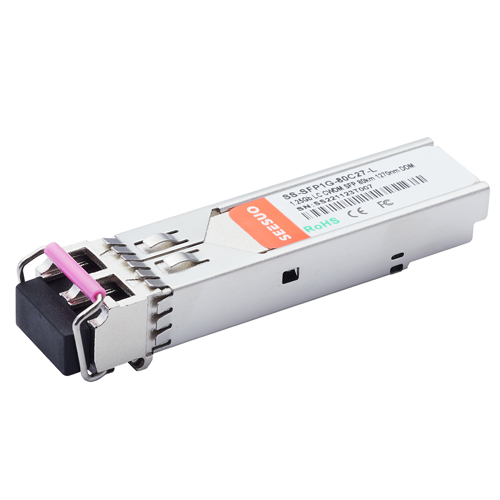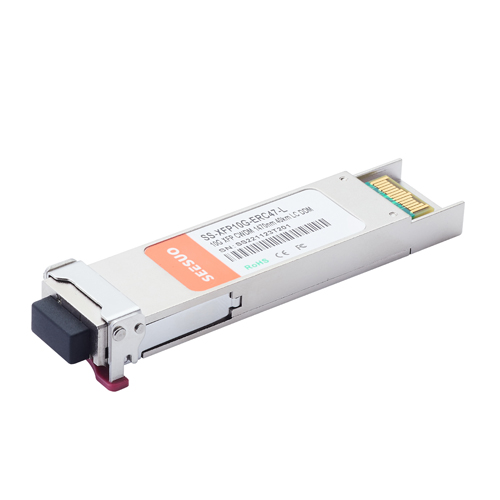- Related articles
- Applicable to 100BASE-FX Standard Optical Transceiver Models
- The Difference between PCI Express SSD and SATA SSD
- How to Configure Settings for Dual NIC Deployments?
- All Cisco GLC-FE-100LX-RGD’s Information (Overview, Features, Datasheet PDF, Price, Specif
- The Difference between GBIC and X2
- All Cisco MGBBX1's information (List price, Specs, Datasheet PDF, Compatibility matrix)
- Difference between GLC-LH-SM and GLC-LH-SMD
- All Cisco QSFP-40G-SR4-S’s Information ( Overview, Features, Datasheet PDF, Price, Specifi
- Optical Transceivers for Cisco WS-C3560V248TSS-RF Switch
- Optical Transceivers for Cisco WS-C4500X-F-32SFP+ Switch

Definition:
The small form-factor pluggable (SFP) is a compact, hot-pluggable transceiver used for both telecommunication and data communications applications. The form factor and electrical interface are specified by a multi-source agreement (MSA) under the auspices of the SFF Committee. It interfaces a network device motherboard (for a switch, router, media converter or similar device) to a fiber optic or copper networking cable. It is a popular industry format jointly developed and supported by many network component vendors.
The XFP (10 Gigabit Small Form Factor Pluggable) is a standard for transceivers for high-speed computer network and telecommunication links that use optical fiber. It was defined by an industry group in 2002, along with its interface to other electrical components, which is called XFI. XFP modules are hot-swappable and protocol-independent. They typically operate at near-infrared wavelengths (colors) of 850 nm, 1310 nm or 1550 nm. Principal applications include 10 Gigabit Ethernet, 10 Gbit/s Fibre Channel, synchronous optical networking (SONET) at OC-192 rates, synchronous optical networking STM-64, 10 Gbit/s Optical Transport Network (OTN) OTU-2, and parallel optics links. They can operate over a single wavelength or use dense wavelength-division multiplexing techniques. They include digital diagnostics that provide management that were added to the SFF-8472 standard. XFP modules use an LC fiber connector type to achieve higher density.
Difference between SFP and XFP module:
SFP Module:
- SFP transceivers are expected to perform at data speeds of up to five gigabits per second (5 Gbps), and possibly higher.
- Because SFP modules can be easily interchanged, electro-optical or fiber optic networks can be upgraded and maintained more conveniently than has been the case with traditional soldered-in modules
- Rather than replacing an entire circuit board containing several soldered-in modules, a single module can be removed and replaced for repair or upgrading. This can result in a substantial cost savings, both in maintenance and in upgrading efforts as compared to old in built modules.
- SFP transceivers are designed to support SONET, Gigabit Ethernet, Fibre Channel, and other communications standards.
- Due to its smaller size, SFP obsoletes the formerly ubiquitous gigabit interface converter (GBIC); the SFP is sometimes referred to as a Mini-GBIC although no device with this name has ever been defined in the MSAs.
XFP Module:
- XFP modules are hot-swappable and protocol independent.
- XFP operates at optical wavelengths of 850nm, 1310nm or 1550 nm.
- Principal applications include 10 Gbit /s Fibre Channel, Synchronous optical networking (SONET) at OC-192 rates, Synchronous optical networking STM-64, 10 Gbit /s Optical Transport Network (OTN) OTU-2, and parallel optics links
- They can operate over a single wavelength or use dense wavelength-division multiplexing techniques
- They include digital diagnostics that provide management that were added to the SFF-8472 standard
- XFP modules use an LC fiber connector type to achieve high density.
Conclusion:
Transceivers are essential for wireless communication devices. The most suggested way of transmitting data is to use light-based fiber optics. “XFP” stands for “10 Gigabit Small Form Factor Pluggable” while “SFP” stands for “Small Form-factor Pluggable.” Both modules can provide you greater signal strength in your computer network, and telecommunication links.























































